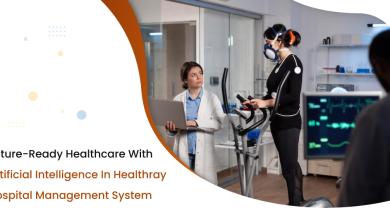
Healthcare services are constantly seeking reliable solutions that can streamline operations by adopting new technologies to improve patient outcomes. As a result, artificial intelligence (AI) is moving to the forefront of clinical systems. While AI is still widely considered to be in its infancy, it has the potential to transform healthcare services around the world by improving clinical outcomes and reducing waiting times.
What Is the Current State of Digitisation in Healthcare?
Whilst the digital age has advanced and revolutionised other sectors, most hospitals in 2025 still rely, to some extent, on paper records. Paper records have obvious downsides, such as storage challenges. For example, NHS and statutory regulations require records to be retained for a certain period of time, which can result in significant storage demands and make it difficult to fully leverage the data they contain. Additionally, paper records are susceptible to physucal damage from light exposure or risks such as fire and water damage that could result in an irreversible loss of critical information due to a lack of readily available backups.
Furthermore, paper records can contribute to significant operational challenges, such as inefficient sharing of information across medical teams and the inability for multiple clinicians to access the same record simultaneously. These limitations hinder the coordination of care and can potentially impact patient outcomes.
In addition to the challenges posed by reliance on paper records, healthcare providers are under pressure to evolve to meet increasing demands; for example, pathologists and lab managers are required to manage the growing volume of slides and blocks which are essential for viewing tissue samples. Many continue to face rising workloads, with the number of histopathology requests to laboratories increasing by around 4.5% on average year on year since 2007.
Equally, some paper-based challenges in pathology are document inefficiencies, where transcription errors in patient information and illegible handwriting can cause interpretation errors. Additionally, there are report management issues, which involve difficulties integrating with electronic health records and challenges in tracking report distribution. Furthermore, audit complexities arise, including demonstrating proper quality control and producing audit trails.
All these challenges impact efficiency and costs in pathology departments. For lab managers, these issues translate to staffing challenges, budget constraints and difficulties in meeting quick turnaround times.
So, is AI the answer?
Much like the introduction of computers and the internet, AI has the potential to transform healthcare in profound ways.
By 2030 we expect AI will support:
- The ongoing transition from paper records to digital systems. Digitisation has already begun to yield benefits, saving storage space and making patient data more accessible, as well as improving efficiency and decision-making. These pave the way for future AI applications to build and improve on these foundations.
- A reduction in waiting times and the number of missed appointments to free up time, money and resources. Predictions suggest that an NHS Trust serving a population of 1.2 million people could save an estimated £27.5 million per year.
- Mainstreaming improved diagnoses thanks to wider adoption of AI-analysed medical images, such as mammograms, offering higher accuracy and faster diagnosis and treatment planning, potentially leading to earlier treatment initiation.
A Game-Changer for Digital Pathology
AI is indeed transforming various aspects of healthcare and is already having a significant impact on digital pathology. Digital pathology, powered by AI, is already streamlining healthcare practices in the US with detection and quantification (mitotic figure counting, automated cancer detection in various tissue types), grading and classification (tumor classification, pattern recognition in complex tissue), workflow enhancements (measurement automation, quality control of slide preparation, case prioritization) improves accuracy in disease diagnosis achieving a mean sensitivity of 96%, making it 2% more accurate than humans and gain new insights beyond what conventional microscopy can achieve. This makes the technology comparable, if not better, than traditional pathologists.
In the UK, the NHS is in the process of adopting digital pathology. Historically, two consultants are required to diagnose digital images. The current issue within many NHS Trusts is that diagnoses can be costly and time-consuming, especially for traditionally resource-restrained hospitals and practices that cannot afford two consultants or require a specialist in a specific type of cancer or disease. Digital pathology, powered by AI, could be trusted to act as one of these consultants, giving an accurate “second opinion” and helping to tackle high workloads.
Challenges and Considerations
Much as with previous revolutionary technology, there is some resistance towards and mistrust of emerging technology. Many medical professionals worry about AI replacing their roles or providing inaccurate information to clinicians and patients. A recent study found that there can be hidden flaws behind expert-level medical technology, resulting in some of the data provided being biased or inaccurate due to the nature of the algorithms.
These issues hint at some wider challenges to consider, such as AI bias, data protection, and regulatory compliance, as well as AI errors or hallucinations leading to misdiagnosis that must be addressed before widespread implementation.
Working Better Together
The integration of AI into health institutions has significant potential when approached as a collaboration tool rather than as a replacement for medical staff and professionals. In these initial stages of AI, we should seek to harness the potential this technology has to offer by automating routine tasks, improving efficiencies and access, and providing diagnostic support. Additionally, AI-powered clinical support can help practitioners, particularly in radiology, such as MRI and CT scan analysis, to improve diagnostic accuracy and speed.
This approach combines the speed and pattern recognition abilities of AI with the irreplaceable human elements of clinical experience and ethical decision-making. Early adoption of AI in the digital pathology space represents a key example of collaboration with AI systems, showing improvements in both diagnostic accuracy by 45% and diagnostic efficiency by 12%.
The future of the healthcare industry depends on a unified partnership between AI and medical professionals that leverages the strengths of both. AI has the potential to drastically improve the way in which we deliver healthcare, creating care provision that is more efficient, equitable, and patient-centered.




